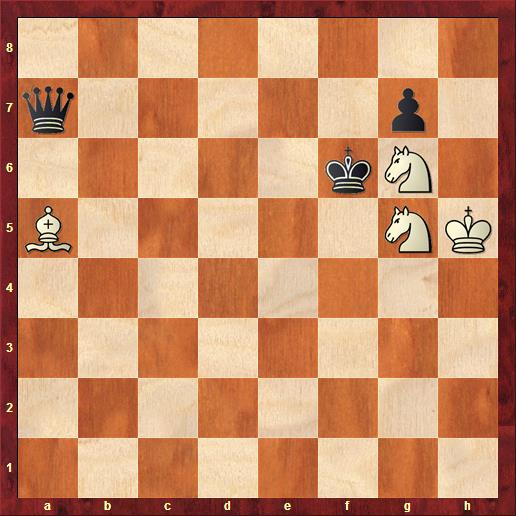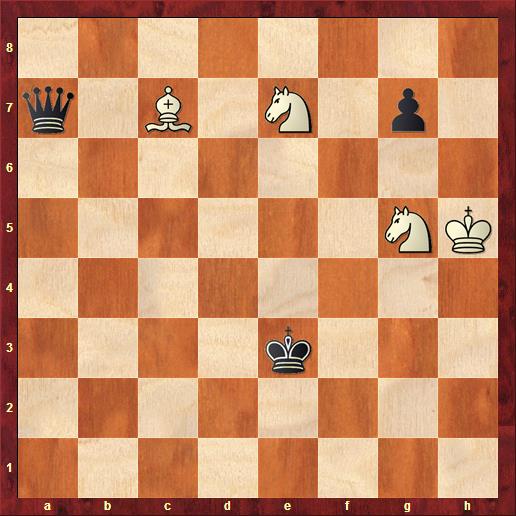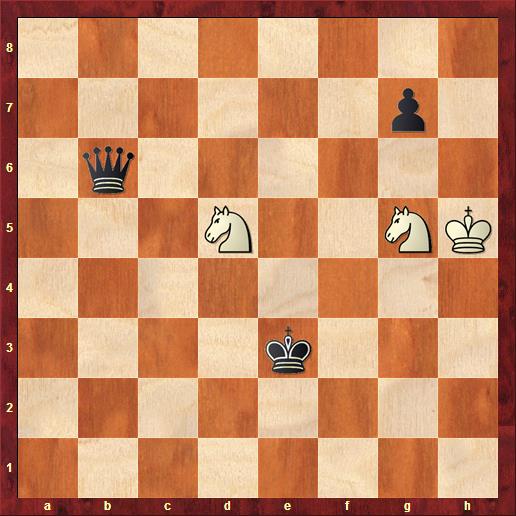I only have time for a quickie this week. Here's another Troitzky study, simple by his standards but charming nonetheless. It's white to play and win. This is actually a one-liner in which black's moves are all essentially forced, so you might want to have a go at solving it before reading on.

We're going to round up the queen with a knight fork. Play begins 1. Bd8+ Kf5 2. Ne7+

Now 2. ... Kf6 walks right into a discovered check, while 2. Ke5 walks right into a knight form on c6. So black must play 2. ... Kf4 after which we get 3. Bc7+!. Wait a sec. Can't black just take the bishop now? That leaves white with just the two knights, which are infamously unable to give mate. Hold that thought. We'll come back to it momentarily.
If black does not take the bishop then he is stuck with 3. ... Ke3:

But now white plays 4. Bb6! Qxb6 5. Nd5+

which picks up the queen. Yay!
But wait. What about that point I raised before, that a king and two knights cannot force mate? Well, that's true, but that's not quite the situation we have right now. Black still has a pawn, and that makes all the difference. You see, king and two knights can force stalemate. With black still having a pawn, the following winning plan suggests itself. White will plant one of his knights in front of the pawn. Then his king and other knight will drive the black king into one of the corners. At a strategic moment, the other knight will then race to the other side of the board to give checkmate, avoiding stalemate by allowing the black pawn to move. Of course, he'd better time everything correctly. Otherwise black might end up queening the pawn, and won't white feel silly then! In this case, though, with the black pawn so far back, the win should be attainable.
It just so happens that Troitzky was something of an authority on the K+2N vs. K+P endgame. My book of Troitzky studies contains his theoretical monograph on the subject, which comes to 60 pages of dense analysis. My understanding is that this analysis is still considered largely correct, which is incredible for someone analyzing these things without a computer.
See you next week!
- Log in to post comments

60 pages of dense analysis.... my lazy mind just reels at the thought of anyone working all this out. And having it stand up to computer analysis -- well, I can only tip my cap to the memory of such a mind as Troitzky possessed.
A very minor nitpick: 4 Bb6 is check, so it is more correctly written as 4 Bb6+.
This may be trivial, but it's not complete until you demonstrate the fork if queen does take the bishop (which is almost identical to the fork you end up with).
Very clever. That pawn on g7 has two functions: it prevents Black from escaping to that square and it causes the mate later.
Oh! Very good point there, MNb! Sends this study up yet another notch.
I wonder what happens if you play in a computer and you end with just two knights. Will it end the game as a draw automatically?
I just tried this with Rybka-3. It plays on, but I suppose it will end after 50 moves.
Interesting problem.Maybe your next post could demonstrate how you mate. I think the details could be interesting.
Lom networks providing best Internship and Development, Technology Solutions, Strategic Consulting and Technology Staffing consulting services. IT Consulting Services in Austin
http://lomnetworks.com/